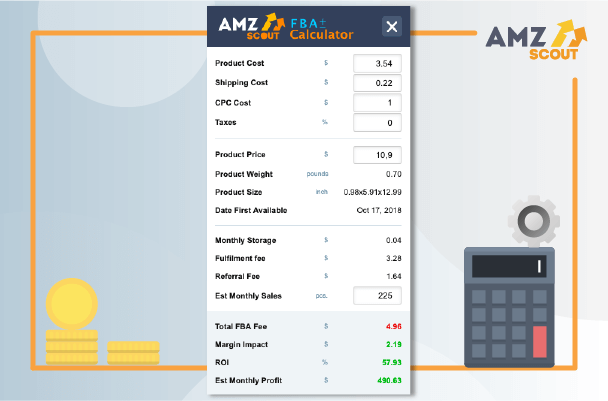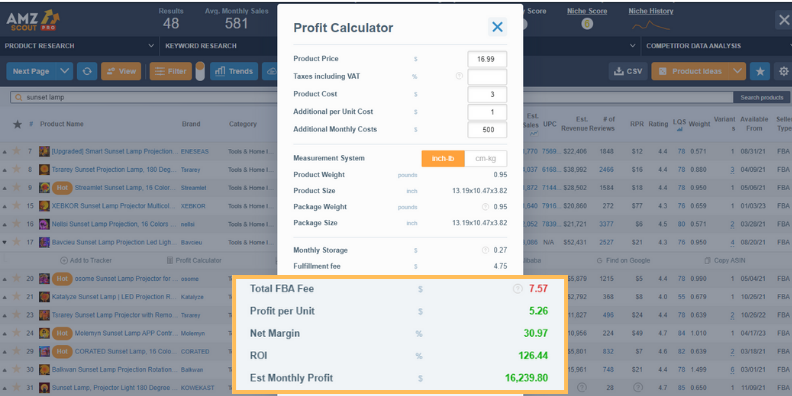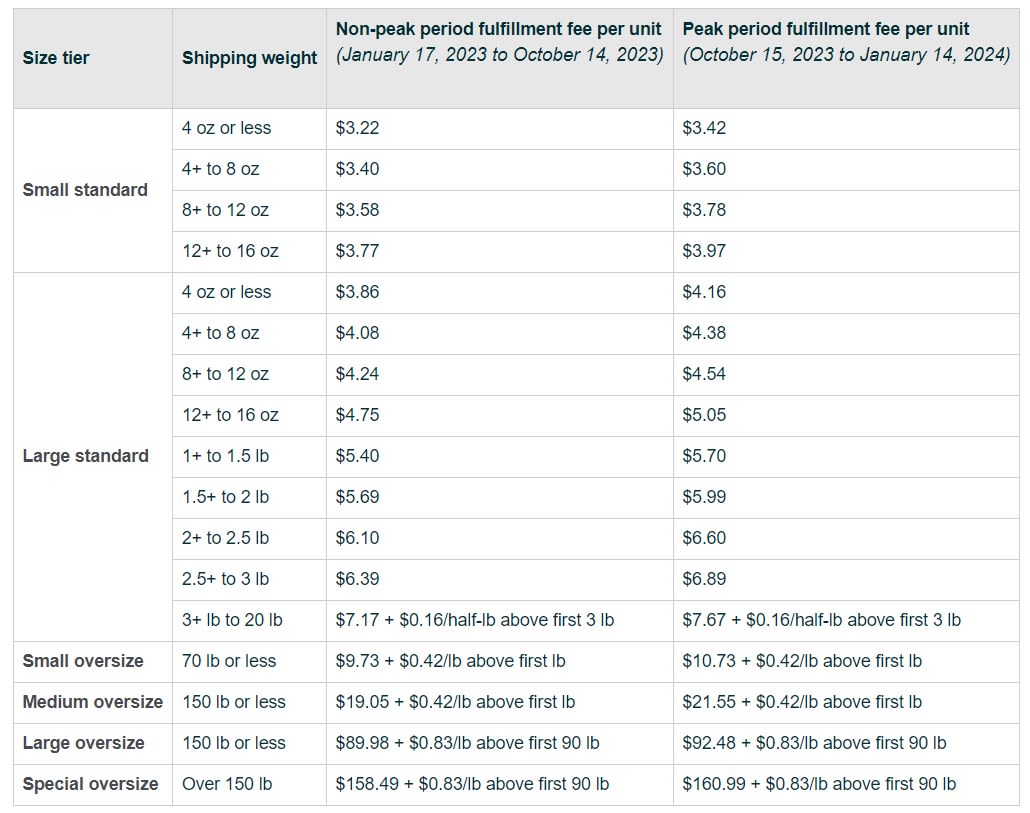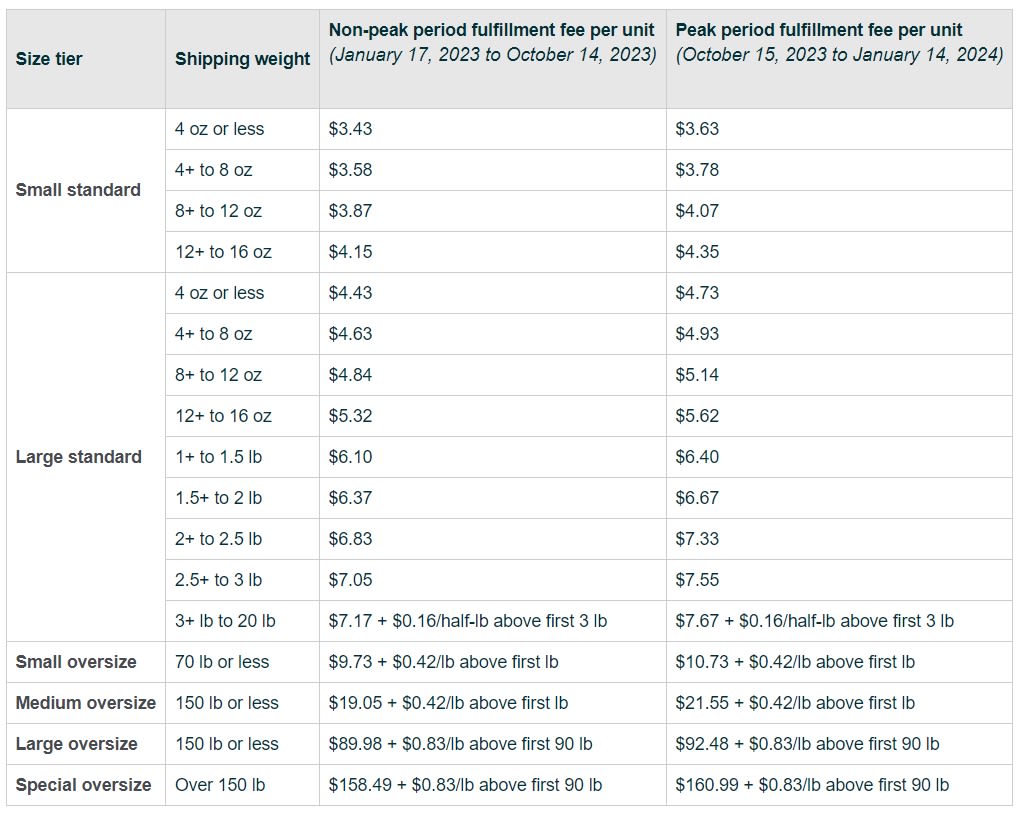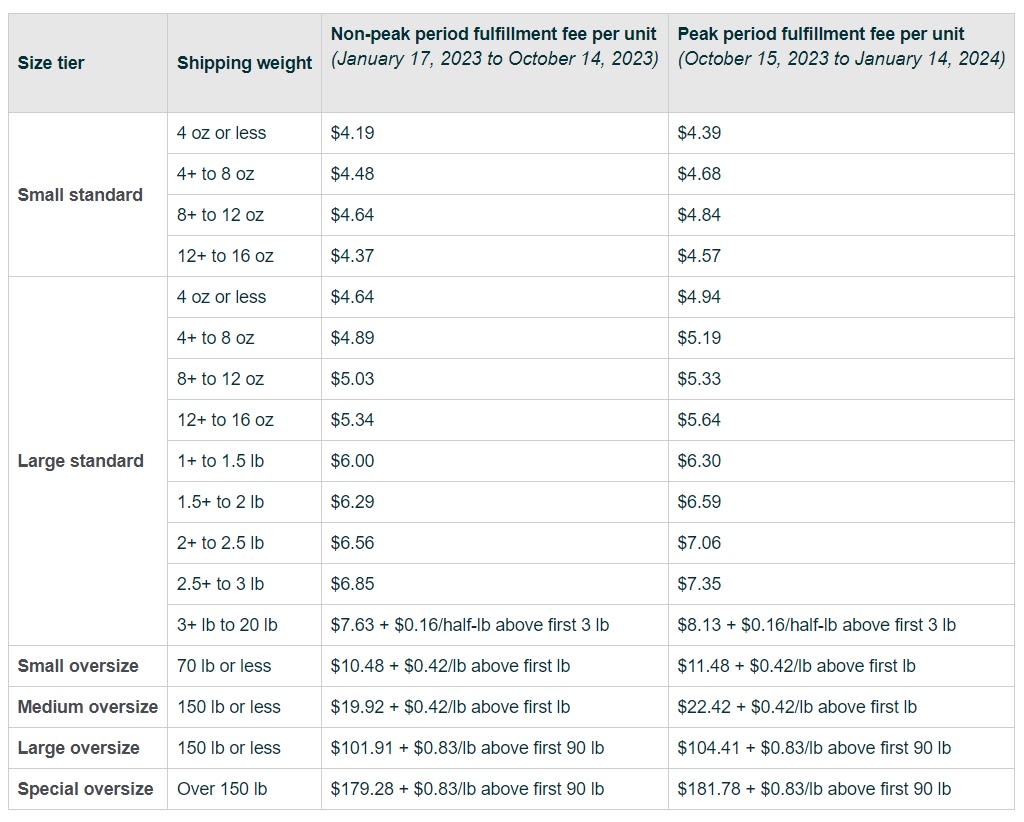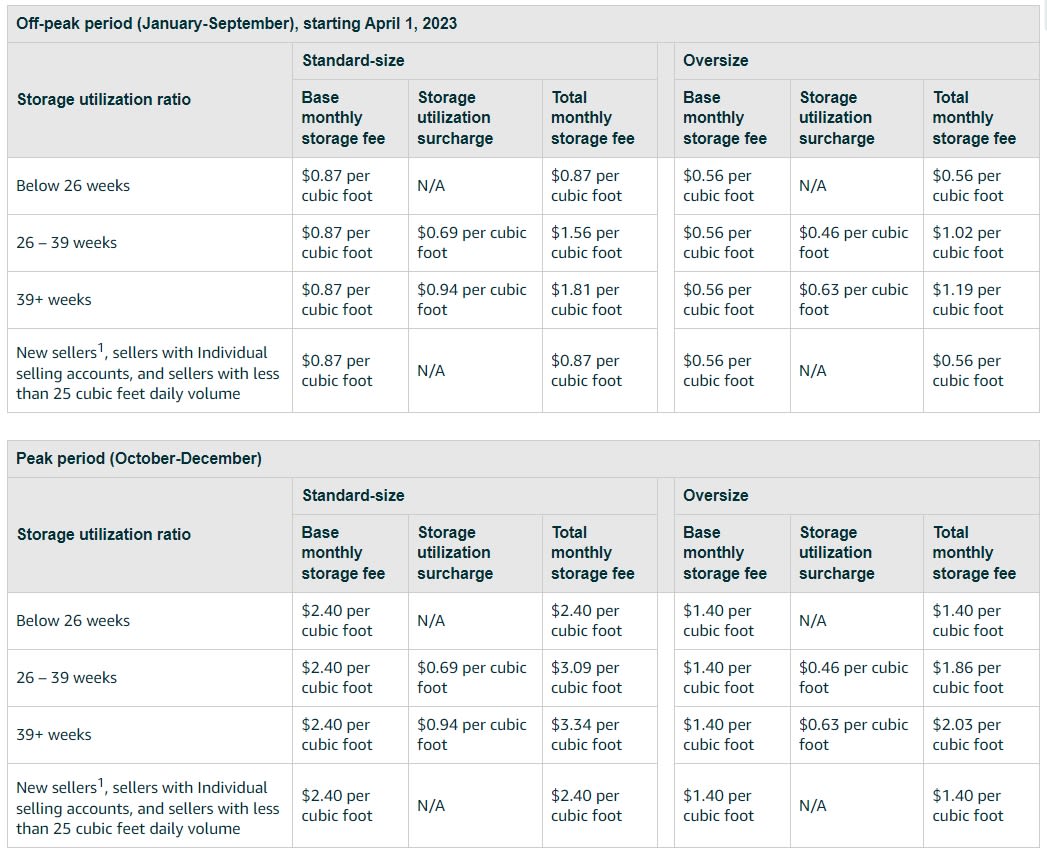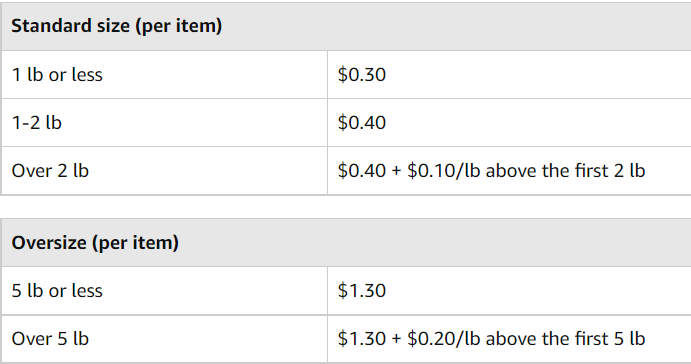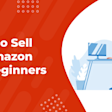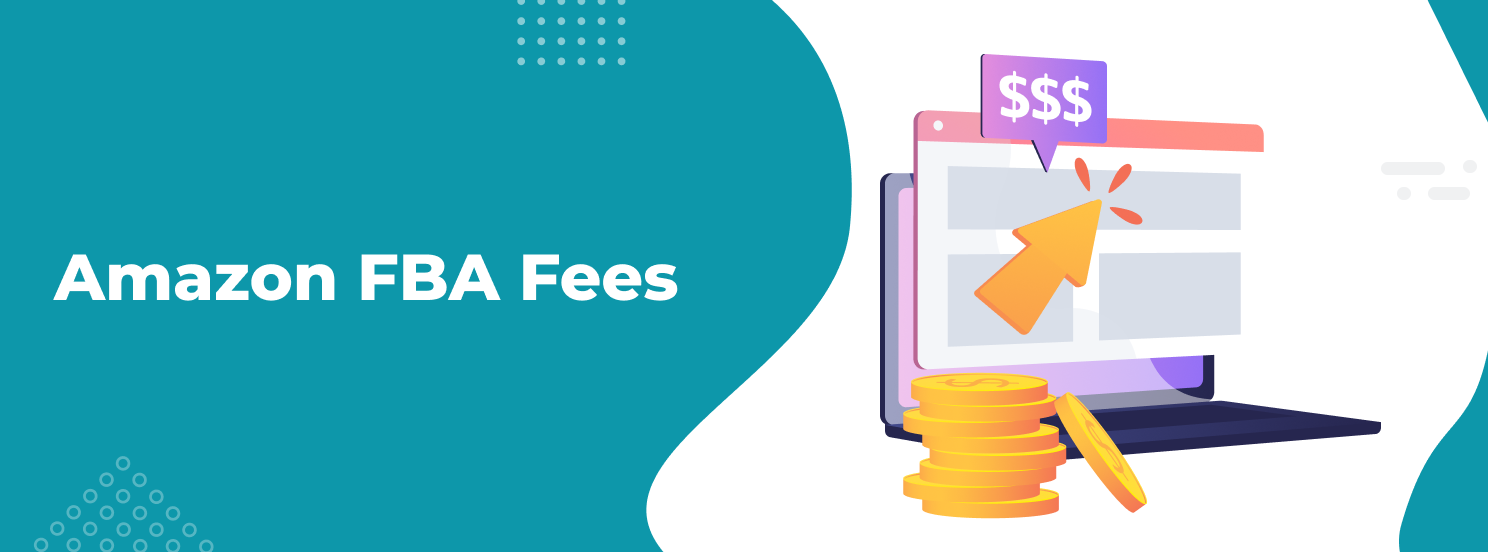
Amazon FBA Fees 2023 Explained
Selling products on Amazon through the FBA program can be very profitable, but it also comes with its share of expenses. Amazon is a business, and if they’re going to grant you access to their platform and services to sell products, they’re going to charge you for it.
That being said, the Fulfillment by Amazon fees are pretty reasonable. While they can be higher for some products, if you know how the fees work and choose the right items to sell, you should have no problem making a profit.
So, just what types of Amazon FBA fees can you expect, and how much are they? Below, we have outlined everything you need to know. Keep reading for a complete breakdown of all the fees you’ll pay, plus some additional information.
Table of content
Note: The fees listed below are for American sellers. If you’re located in other countries, like Canada or India, your fees will be different. Go to Amazon Seller Central to find out the exact fees for your country.
Types of Amazon Fees
As a seller, you need to know all the types of fees charged by the platform where you publish your products. This is essential when planning an effective business, gaining profitability, and saving money.
Here are the main types of fees that Amazon charges:
Fulfillment Fees
Fulfillment fees cover the cost of storing, picking, packing, and shipping your products to customers. They vary based on the size and weight of each item, as well as your desired fulfillment option (Fulfilled by Amazon or Seller Fulfilled Prime).
Storage Fees
This type of fee is charged for holding your inventory in Amazon's fulfillment centers. Storage fees depend on the amount of space your products occupy, as well as whether it’s during peak or non-peak seasons.
Referral Fees
These fees are calculated based on a percentage of the item's sale price that Amazon charges for facilitating the sale on their platform. They vary depending on the category, and help cover the cost of marketing, customer service, and maintaining the online marketplace.
Additional Fees
These include a range of charges that might apply in a variety of situations. For example, Advertising Fees, Returns and Refunds, and Removal Fees for disposal of items .
In this article, you’ll learn how to estimate fees with the help of a calculator, as well as how you can reduce them with ease.
How to Easily Calculate Your FBA Fees
As you can see, there are a number of different variables that can potentially determine the fees you’ll need to pay as an Amazon seller. Because of this, it can be difficult to apply all of the rules listed above and accurately estimate exactly what your fees will be.
Luckily, there are two convenient solutions to help you do this. The first is the AMZScout FBA Calculator.
1. Download the AMZScout FBA Calculator.
2. Open the Calculator:
Go to the Amazon marketplace.
Open the listing for a product you want to analyze.
Click the AMZScout FBA Calculator icon in the browser extension menu.
3. Check the FBA fees shown in the Calculator.
4. Calculate additional indicators such as ROI, margin and profit. Fill in the details. Enter Taxes (including VAT), Product Cost, etc.
The second option is the AMZScout PRO Extension, which works similarly to the calculator.
1. Download the AMZScout PRO Extension.
2. Open the Extension:
Amazon will open automatically once the Extension is installed.
Start a free trial. If you’re new, you’ll see a sign-up form. Fill in your information to start your trial.
Search for a product that you want to check.
Once you have the results, click the AMZScout symbol in the lower-left corner of your browser to open the Extension.
3. Check the FBA fees column for each product.
4. Review the breakdown of these fees. Click the Profit Calculator icon. You can also enter your details into the fields.
5. Look at your results. The Calculator will automatically calculate your FBA fees, Net Margin, ROI, and other metrics.
You can also use the PRO Extension to analyze entire niches. Type keywords into the Amazon search bar, and then once your results appear, open theExtensionYou can analyze sales, reviews, rank, and trends for all of the products listed there. You can also utilize the Niche Score and Product Score features to determine an overall assessment of niche or product potential, considering demand, competition and more.
With the help of these tools, you can quickly get a preview of your FBA fees and analyze critical data that will enable you to make informed decisions for your business.
What do Amazon Fees Depend On?
After you've calculated your Amazon fees, it's beneficial to understand how you can reduce them. You can apply various strategies based on the type of an Amazon fee.
What do Fulfillment Fees Depend On?
Let’s recap what fulfillment fees are once again. This is a percentage of the product price charged by Amazon for the services of storing, picking, packing, and shipping products to customers. These fees allow sellers to outsource their logistics and order fulfillment process to Amazon.
You can read more about fulfillment fees on the Amazon website.
These fees can vary based on different factors: product size and weight, category, and seasonality. It's important for sellers to understand and calculate their fees accurately, as they will directly impact the overall cost structure and profitability of their business on Amazon.
Here are a few tips to help you minimize your fulfillment fees at the stage of product selection:
Avoid large items and dangerous Goods. Choose products that are small, light, and not considered dangerous.
Avoid selling clothes and other apparel. Your fulfillment fees will increase if you’re selling any kind of clothing, so try to avoid these items if possible.
What do Storage Fees Depend on?
Amazon storage fees are charged for keeping any inventory in Amazon's fulfillment centers. Storage fees can vary based on the amount of time products remain in Amazon fulfillment centers, product size, and seasonality.
You can read more about storage fees on the Amazon website.
Here are a few tips to help you minimize your storage fees on the basis of factors they depend on:
Choose small and light products. Selecting smaller items can significantly reduce your storage fees, as the size of the product impacts the cost. For optimal results, look for small items with a healthy profit margin.
Avoid dangerous goods. Amazon applies higher charges for items classified as "dangerous goods," which encompass flammable, pressurized, corrosive, and harmful substances. Examples include batteries, hairspray, and insecticides. Familiarize yourself with Amazon's hazardous product categories so you can steer clear of them and lower your storage fees.
Be careful about storing products Between October and December, storage fees surge due to heightened sales activity. Aim for products that have a quick turnover to avoid extended storage. Analyze your yearly sales data and focus on top-performing items, rather than introducing untested products during this period.
Avoid storing your items with Amazon Long-Term Reducing storage duration with Amazon is key to minimizing your monthly fees. Items stored for more than six months incur additional charges. Prioritize selling products swiftly or store them in prep centers, if you are an Amazon FBM seller. It’s better to sell the item at cost rather than having to pay to have Amazon dispose of it for you.
Utilize restocking fees If one of your customers returns an item they purchased from you, and the return is their fault (they no longer need the item, they bought it by mistake, etc.) you can charge them a restocking fee of 20% of the cost of the item. This can help offset your storage fees for that item.
What do referral fees depend on?
Sellers pay this type of fee to Amazon for the privilege of selling their products on the Amazon platform. These fees are a percentage of the item's sale price and are based on the product category. Referral fees range from 6% all the way up to 96%. Essentially, this represents the commission for using Amazon to reach a vast customer base and benefit from its extensive infrastructure.
You can read in detail about referral fee percentage here.
The more sales you generate, the lower your referral fee. There are two ways to increase sales:
Use Amazon FBA. FBA comes with storage and fulfillment fees, and it can help you qualify for Amazon's "Fulfilled by Amazon" badge, which can result in higher visibility and potentially more sales. This can offset the referral fees with increased sales.
Offer bundles or multi-packs. Product bundles and multi-packs can help you sell more units per transaction which can reduce the impact of individual referral fees.
Always stay informed about Amazon's referral fees, as these might change over time, and be sure to consult Amazon's official resources for accurate and current information.
What do additional fees depend on?
These fees include advertising, returns and refunds, and removal fees on Amazon. To reduce them effectively, you need to use strategic planning and proactive management. Here are some tips or each of these areas:
Reducing Advertising Fees
Optimize keywords. Focus on relevant keywords in your Amazon advertising campaigns. Use tools, like Amazon's Keyword Research, to help you identify high-performing keywords that match your products. Use keywords that closely match your products, and your ads will be shown to customers who are interested in your product.
Identify negative keywords. Regularly review search term reports and identify irrelevant or low-converting keywords. Add these as negative keywords to prevent wasted ad expenses.
Reducing returns and refunds
Write detailed product descriptions. Provide comprehensive and accurate product descriptions, including size, specifications, and features. This can reduce the likelihood of customers receiving products that don't meet their expectations.
Add clear images. High-quality images can give customers a realistic view of the product, minimizing the chances of dissatisfaction upon receipt.
Include size charts. For apparel and other size-dependent items, include size charts to help customers choose the correct size and reduce returns due to improper fit.
Maintain an accurate inventory. Ensure that your inventory is up-to-date to avoid customers ordering products that are out of stock or unavailable. Accurate stock levels prevent customers from placing orders for items that are unavailable, and minimize the need for cancellations because of unfulfilled orders.
Reducing Removal and Inventory Placement Fees
Conduct consistent inventory management. Monitor your inventory levels to prevent overstocking or holding onto slow-moving products for extended periods, which can lead to removal fees.
Review inventory reports. Regularly review inventory health reports in Seller Central to identify items at risk of incurring removal fees due to extended storage periods.
Remember that Amazon's policies and fee structures can change, so it's important to stay updated through Amazon's official resources or Seller Central.
Changes to Amazon Fees in 2023
Amazon regularly implements adjustments to its fulfillment, storage, referral, and additional fees. These modifications can impact sellers’ expenses and should be thoroughly taken into account. This overview will highlight the key changes in Amazon fee structure.
Let's explore these in detail and discuss how these changes might affect your business operations.
Changes to Fulfillment Fees in 2023
In 2023, there has been an average increase of $0.22 in FBAfulfillment fees. We have outlined Theus year’s changes below.
Amazon has increased its fulfillment fees for all of its products beginning January, 2023. The platform has introduced new size tiers for which fulfillment costs are different.
Here are the fee changes for all items:
Small/Large/Oversized Standard Items
Small, large, and oversized items will be seeing a net increase across the board, averaging nearly $0.20 per unit.
Larger items can expect expense increases anywhere from $0.50 and $3.00
Focus particularly on the “medium oversize” category, which is seeing a per-pound increase of $6.00! This increase is huge, so be attentive.
Apparel will also be seeing similar increases across the board.
Small/Large Standard Apparel
Apparel items will be seeing similar increases ($0.20), with larger items sitting at over $3.00 per unit.
Products that are classified as “dangerous goods” will also see an increase in fulfillment fees. These increases are the same as increases for standard items.
Here are the changes for standard items that are deemed “dangerous goods”:
Small/Large/Oversize Dangerous Items
Dangerous items are seeing similar increases as standard items, varying from 20 cents to $300.
The same per-pound increase from above of $0.05 applies to dangerous items as well.
For those who ship items from the small and light category, you can also expect significant fee changes.
Small and Light Large Standard Items
Prior to January 17, 2023, anything from 4 to 8 oz. was not priced under this category. You can expect major changes if you sell these quantities in the small and light categories.
Changes to Amazon Storage Fees in 2023
As of February 1, 2023, Amazon’s storage fees have increased as follows:
January-September: $0.87 (standard-size) and $0.56 (oversize) per cubic foot. This change was reflected in March, 2023 for storage that occurred in February, 2023.
October-December: $2.40 (standard) and $1.40 (oversize) per cubic foot.
This is an increase of $0.03 per cubic foot under the storage rates for January through September and $0.20 under those for October through December.
Starting from April 15, 2023, Amazon has made improvements to how long they handle aged inventory surcharges (previously known as long term storage fees) for items stored between 271 to 365 days. Additionally, they have introduced three new tires that will apply to l products aged 181 to 270. In general, this increase is more than $1.00 per cubic foot, so be aware of it.
Here’s a breakdown of Amazon’s storage fee schedule:
Monthly Storage Fees for Standard Items
Changes to Amazon Referral Fees in 2023
Amazon’s services are usually around 30% cheaper than other eCommerce providers, and you can relax for now, as they are expected to remain the same for the rest of 2023. They start from 8% and can go up to 15%, and will also depend on the type of product you sell.
Always stay tuned and keep an eye out for all of the announcements Amazon makes at the end of each year on their website.
Changes to Amazon’s Additional Fees
There are a few other Amazon fees you should keep in mind when starting your business. They haven’t changed since 2022. Here’s a quick breakdown for 2023.
FBA manual processing fees need to occur when you do not provide box content information. In this case, you should expect these fee rates:
JanuaryOctober: $0.15 per unit
November-December - $0.30 per unit
Amazon also offers an inventory placement service that allows you to send all of your eligible inventory to a single receiving center. This service will take your shipment and spread it amongst multiple fulfillment centers, giving your products a greater reach.
Here are the inventory placement fee rates per item:
You also need to consider inbound services fees, which is the cost of using Amazon's partnered carriers (UPS and FedEx) to ship your inventory domestically within the US to Amazon. There is no set rate for these fees, but on average they usually work out to about $0.30 per unit.
Finally, as with any business, consider the taxes you’ll have to pay on your Amazon earnings. Make sure to set that money aside so you have it when it’s time to file your taxes.
Conclusion
Before you decide to sell any product on Amazon, be sure to carefully calculate all the costs and profitability, and take fees into account as they will play an important role in calculating your costs.
Also, don’t forget to check out the AMZScout FBA Calculator and PRO Extension, as they will help you calculate your fees easily so you can determine whether a product is worth selling.

